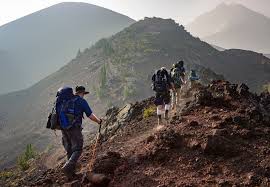Mountain Hiking in Uganda
 Mountain Hiking in Uganda , hiking, or mountain trekking, is a popular outdoor activity that involves walking or trekking through mountainous terrain. It’s a physically challenging but rewarding activity that allows enthusiasts to enjoy the beauty of high-altitude landscapes.
Mountain Hiking in Uganda , hiking, or mountain trekking, is a popular outdoor activity that involves walking or trekking through mountainous terrain. It’s a physically challenging but rewarding activity that allows enthusiasts to enjoy the beauty of high-altitude landscapes.
Whether you’re a seasoned hiker or a beginner, here are some general tips and considerations for mountain hiking:
Choose the Right Mountain:
Consider your fitness level and experience. Some mountains are more challenging and require advanced skills, while others are suitable for beginners.
Research the specific mountain you plan to hike, including its elevation, difficulty level, and any permits required.
Check Weather Conditions:
Mountain weather can be unpredictable, so check the forecast before heading out. Be prepared for sudden changes in temperature, wind, and precipitation.
Dress in layers to adjust to changing weather conditions.
Plan and Prepare:
Plan your route in advance, considering factors such as distance, elevation gain, and estimated time.
Inform someone about your hiking plans and expected return time.
Pack essentials, including water, snacks, a first aid kit, map, compass, and any necessary permits.
Fitness and Acclimatisation:
Mountain hiking can be physically demanding, especially at higher altitudes. Regular cardiovascular exercise can help improve your fitness for the trek.
If hiking at high elevations, consider acclimatising to the altitude by spending a day or two at a lower elevation before ascending.
Proper Gear:
Wear appropriate footwear with good ankle support, as mountain trails can be rocky and uneven.
Use trekking poles for stability, especially during descents.
Invest in quality outdoor gear, including a backpack, rain gear, and a headlamp or flashlight.
Navigation:
Familiarize yourself with the trail and carry a map and compass or a GPS device.
Follow trail markers, cairns, or any other designated route indicators.
Leave No Trace:
Practice Leave No Trace principles by packing out all waste and avoiding damage to vegetation.
Stay on designated trails to minimize your impact on the environment.
Safety First:
Be aware of potential hazards, such as wildlife, steep drops, and changing weather conditions.
Know your own limits and turn back if conditions become unsafe.
In case of an emergency, have a plan for communication and know the location of the nearest emergency services.
Respect Local Regulations:
Be aware of and adhere to any regulations or rules set by the local authorities or park management.
Enjoy the Experience:
Take your time to enjoy the stunning scenery, flora, and fauna. Appreciate the unique environment that mountain hiking provides.
Uganda offers a variety of mountain hiking opportunities for outdoor enthusiasts.
Some of the notable mountains and hiking destinations in Uganda include:
Rwenzori Mountains (Mountains of the Moon):
The Rwenzori Mountains are a UNESCO World Heritage Site and offer some of the most challenging and rewarding hiking experiences in Uganda.
Margherita Peak, the highest point on Mount Stanley, is a popular destination for serious trekkers. The trek takes several days and involves navigating through diverse landscapes, including glaciers and alpine meadows.
Mount Elgon:
Located on the border of Uganda and Kenya, Mount Elgon is an extinct volcano with a large caldera. It offers various hiking trails suitable for different fitness levels.
The Sasa Trail and Sipi Falls Trail are popular routes leading to the Wagagai Peak. The trek takes a few days and provides stunning views of the surrounding landscapes.
Mount Moroto:
Mount Moroto is part of the Moroto Mountain Range in northeastern Uganda. It offers a less-visited but scenic hiking destination.
The hike to the summit of Mount Moroto takes around 4-6 hours, and it provides panoramic views of the Karamoja region.
Mount Sabinyo:
Mount Sabinyo is one of the Virunga Volcanoes located in Mgahinga Gorilla National Park. It straddles the border between Uganda, Rwanda, and the Democratic Republic of the Congo.
The hike to the summit of Mount Sabinyo is challenging but rewarding, offering breathtaking views of the surrounding volcanoes and landscapes.
Mount Gahinga:
Also located in Mgahinga Gorilla National Park, Mount Gahinga is another of the Virunga Volcanoes.
The trek to the summit of Mount Gahinga is less strenuous compared to some of the other peaks, making it suitable for a one-day hike.
Mount Kadam:
Mount Kadam is located in the northeastern part of Uganda, near the border with Kenya. It offers a less-explored hiking destination with diverse flora and fauna.
Mount Morungole:
Situated in Kidepo Valley National Park, Mount Morungole provides a unique hiking experience in the remote and scenic Karamoja region.
Mount Napak:
Mount Napak is part of the Kadam Mountain Range in Karamoja. Hiking here offers a chance to explore the less-visited areas of northeastern Uganda.
Mount Otzi:
Mount Otzi is one of the peaks in the Elgon Range. It provides an alternative hiking experience for those looking to explore less-traveled trails.
Mgahinga Gorilla National Park:
Apart from Mount Sabinyo and Mount Gahinga, Mgahinga Gorilla National Park offers other hiking trails with scenic landscapes and the opportunity to see mountain gorillas and golden monkeys.
Bwindi Impenetrable Forest:
While known primarily for gorilla trekking, Bwindi Impenetrable Forest also offers challenging hiking trails that lead through dense jungles and high-altitude areas.
Sipi Falls:
While not a mountain in itself, Sipi Falls in the foothills of Mount Elgon provides excellent hiking opportunities. The area is known for its stunning waterfalls, coffee plantations, and panoramic views.
When planning a mountain hiking trip in Uganda, it’s crucial to check the current status of the trails, weather conditions, and any necessary permits. Additionally, consider hiring experienced guides, as they can enhance your safety and overall experience while providing valuable insights into the local culture and environment. Always practice responsible and sustainable tourism to preserve the natural beauty of these destinations.
